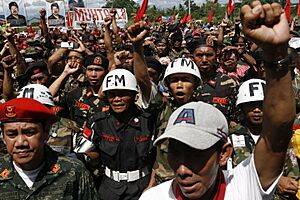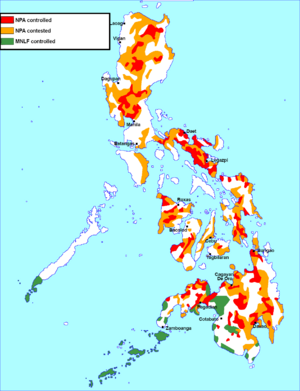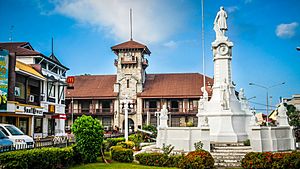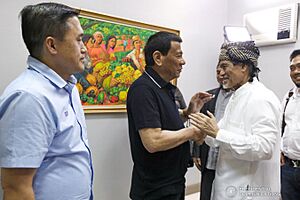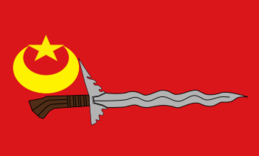Moro National Liberation Front facts for kids
Quick facts for kids Moro National Liberation Front (MNLF) |
|
|---|---|
| الجبهة الوطنية لتحرير مورو | |
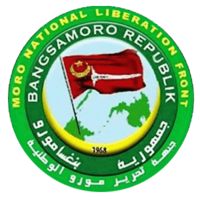
Seal
|
|
| Leaders | Nur Misuari (founding chairman) and Mus Sema (MNLF EC-15) |
| Dates of operation | October 21, 1972 – September 2, 1996 (as a secessionist group) September 2, 1996 – present (as a political organization) |
| Headquarters | Sulu, Philippines |
| Active regions | Mindanao, Philippines |
| Ideology |
Anti-Malaysian sentiment (Misuari faction) |
| Allies | State allies
|
| Opponents | State opponents
|
| Flag |  |
The Moro National Liberation Front (MNLF) is a political group in the Philippines. It was started in 1972. The MNLF was very active in the Moro conflict for about 20 years, starting in the 1970s.
In 1996, the MNLF signed an important peace agreement with the Philippine government. This agreement led to the creation of the Autonomous Region in Muslim Mindanao (ARMM). This area allowed the mostly Muslim population to have some self-rule. Nur Misuari, a leader of the MNLF, became the governor of this region. However, his time as governor ended when he led a failed uprising in 2001. He then fled to Sabah but was sent back to the Philippines by Malaysia.
The MNLF is recognized by the Organisation of Islamic Cooperation (OIC). Since 1977, the MNLF has been an observer member of the OIC. This means they can attend meetings and watch discussions.
Contents
Why the MNLF Was Formed
For many years, the Philippine government encouraged Christian families to move to Mindanao. This was part of a program from 1903 to 1973. At that time, many native people in Mindanao did not have official land titles. Christian settlers sometimes took advantage of this. This led to arguments over land and made many Muslims feel left out. This program is one of the main reasons for the Moro conflict.
Also, poverty and a weak rule of law in the Southern Philippines made it hard to deal with armed groups.
A sad event happened on March 18, 1968, involving Moro soldiers. This event helped lead to the creation of groups like the Bangsamoro Liberation Organization (BMLO). These groups wanted to protect and develop Islam in the Philippines. Their ideas later inspired the MNLF. Some people believe that Malaysia helped train and arm the first MNLF members in 1969.
Nur Misuari founded the MNLF on October 21, 1972. The MNLF says its main idea is egalitarianism, which means everyone is equal. It is a non-religious movement, unlike some other groups.
MNLF Leadership and Changes
The MNLF was the main group for Moro separatists for about 20 years. But after the 1996 peace agreement, some members became unhappy with Nur Misuari's leadership. Also, former rebels joining society again changed the group. Today, there are several different groups that used to be part of the MNLF. For example, one group supported a peace deal in 2012, even though Nur Misuari did not like it.
Some reports have mentioned that certain groups involved in the conflict have included young people.
Steps Towards Peace
In 1976, a peace agreement called the Tripoli Agreement was signed. This agreement aimed to create an area where Muslim Filipinos could govern themselves. However, the agreement did not work out as planned. The Philippine President at the time decided to create two smaller self-governing regions instead of one large one. This led the MNLF to continue their armed struggle.
In the 1980s, the MNLF changed its goal from full independence to wanting more self-rule. There were attempts at a ceasefire and peace agreement in 1986, but they failed.
The Autonomous Region in Muslim Mindanao was created in 1989, even though the MNLF was against it.
Later, Philippine President Fidel V. Ramos encouraged Indonesia and the OIC to help with the peace process. This led to the Jakarta Agreement in 1996. This agreement aimed to fully put the 1976 Tripoli Agreement into action. A key person in these talks was Sayyid Al-Hassan Caluang, who helped arrange meetings between MNLF elders and the government.
Some issues that have caused problems between the Philippine Government and the MNLF include sharing mineral wealth and disagreements about how to carry out the peace agreement.
In 2015, Nur Misuari said the MNLF was not involved in the North Borneo dispute. He stated that only the Sultanate of Sulu could discuss the claim over Sabah with Malaysia. The MNLF believes Sabah is a peaceful home for many different Muslim groups from Southeast Asia.
The European Union and the United States do not consider the MNLF a "terrorist" group.
Zamboanga City Incident
In 2013, Nur Misuari's group within the MNLF declared independence for the Bangsamoro Republik. They then attacked Zamboanga City. During this event, the group was accused of using civilians as human shields. This led the Philippine government to call them terrorists.
The MNLF Today
The Moro National Liberation Front, led by Nur Misuari, has had discussions with former Philippine President Rodrigo Duterte. Misuari and Duterte met several times after the Bangsamoro Organic Law (BOL) was signed. Duterte also considered giving more self-rule to Misuari's group.
A special committee was formed to help complete the remaining parts of the 1996 Final Peace Agreement. This committee also works on security and economic issues in Sulu. It aims to help resolve conflicts in Mindanao with the MNLF's help.
In August 2022, Abdulkarim Misuari and Nurrheda Misuari, along with four others, were appointed as Members of Parliament for the Bangsamoro Transition Authority. This appointment lasts until the regular elections for the Bangsamoro Parliament in 2025.
Members of the MNLF's Executive Council of 15 were part of the Bangsamoro Transition Commission with the Moro Islamic Liberation Front. Some leaders, like Yusop Jikiri and Muslimin Sema, supported the Bangsamoro Organic Law. After this law was passed, members of the EC-15 were appointed to the Bangsamoro Transition Authority.
In 2023, the groups led by Misuari and Mus Sema came together to work on putting the 1996 agreement into action.
MNLF Flag
The flag of the Moro National Liberation Front has a golden yellow star and crescent, and a kris (a type of dagger) on a red background. The star stands for truth, fairness, equality, and tolerance. The crescent moon symbolizes wisdom. The kris represents strength. The red background shows the Bangsamoro people's activism, determination, and sacrifices in their fight for survival and self-determination. Even though it has a star and crescent, which are often linked to Islam, the flag's design is meant to be non-religious. There are different versions of the flag because its design has not been fully standardized.
See also
- Bangsamoro Party


